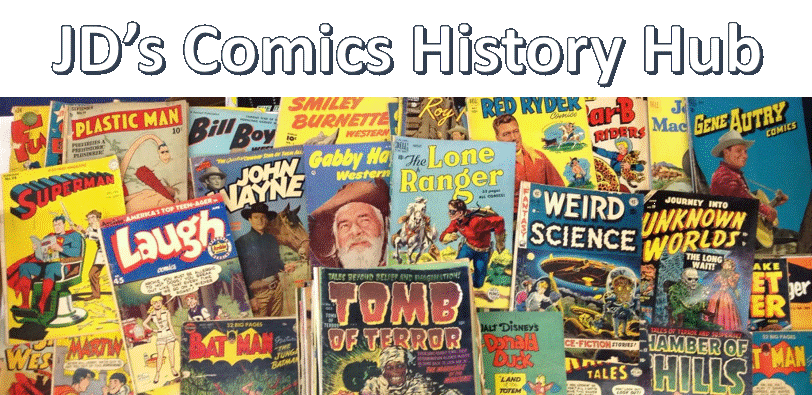In Comics Buyer’s Guide #1627 (April 2007), columnist Captain Comics (Andrew Smith) offered up capsule reviews of every issue of The Brave and the Bold, DC Comics's Silver Age superhero team-up series. His review of issue #63 (January 1966), though, stuck in my craw. That issue featured a team-up of Supergirl and Wonder Woman, DC's two biggest female super persons, in a story entitled "Revolt of the Super-Chicks." It was one of my favorites of the era, but the good Captain declared, "There's nothing significant about 'Revolt of the Super-Chicks,' except how out of character (and amazingly sexist) I thought it was when I first read it - and even moreso now, as an adult." I was so dismayed by the review that I ran to my computer and tapped out an impassioned response. The Captain ran it in Comics Buyers Guide #1630 (July 2007), and here it is:
Dear Captain Comics,
Loved the overview of Brave & Bold teamups in CBG #1627, but man, you dissed one of my favorite comic books! How could you say there was "nothing significant" about B&B #63 (January 1966)? I mean, come on, it's gotta be one of the most entertaining and noteworthy stories of the entire Silver Age. At least I think so. Ever since my nine-year-old little hands first grasped it, I've loved that particular issue. And my ardor has only deepened in the intervening 40+ years. Here's why:
To begin with, it is, I believe, the first-ever teamup of two super heroines - at least in a book-length story. That alone has to count for something.
Second, thanks to Bob Haney's delightful script, the characters reveal more personality than they were ever allowed in their own titles. You complain about "how out of character" they are, but that's only because, as you well know, in the Silver Age, DC super types rarely had any character at all; the only thing that differentiated them was their super powers. Haney took the company's top two gal guardians and gave them some life. Sure, it was different, but how is that a bad thing? If today's writers can use an Elseworlds format to express their own personal takes on a character, what's wrong with Haney using B&B for the same purpose?
I mean, where else will you see Supergirl as a rebellious teenager and Superman a befuddled father figure. "Oh, you sound like a stuffed shirt, Superman!" the girl of steel exclaims. "What do you know about women...How they feel--what they really need? You may be a great hero...But in the romance department--Well, just ask Lois Lane!" To which Superman bumblingly replies, "Why...uh...ulp...I--I'm very fond of girls...I...uh..." Come on, admit it. This is a lot more fun than the stolid stuff then being served up in the regular Super-titles.
Third, and most important, the story says a lot about its era. Here's the picture: Supergirl feels boxed in by the limited role imposed on her by society and decides to run off and find her own identity. (Okay, so that "limited" role happens to be mega powerful protector of the universe, but you get the idea.) A puzzled Superman just doesn't get it, and can't figure out why his wife - excuse me, cousin - doesn't want to stay home and in his shadow where she belongs. Remember this was a scant three years since Betty Friedan's The Feminine Mystique, and America's women and their husbands were pondering this very same question. (Albeit, without the super powers and tights, but come on, work with me here!)
That Haney and editor George Kashdan had feminism in mind when they came up with this tale is supported by the fact that the issue's accompanying text story is about accomplished women like founding feminist Susan B. Anthony, Elizabeth Blackwell (the first woman doctor in the U.S.), and Emma Willard (a pioneer of education for girls).
Now, granted, there is the admittedly sexist sequence where Supergirl and Wonder Woman, threatened by the villain of the moment, have to save their respective boyfriends surreptitiously, so as not to reveal their super abilities. Because, let's face it, what self-respecting mid-sixties type guy would find a gal feminine who could bench press ten times his weight? (Though I doubt Friedan ever read B&B #63, she does weigh in on the issue when she decries a McCall's story in which the heroine is "a nineteen-year-old girl sent to a charm school to learn how to bat her eyelashes and lose at tennis.")
So is this story anti-feminist or pro-feminist? The answer is both. And that's what makes it interesting - and so very much "of it's time." Just as men and women during this time of transition were confused about gender roles, so is this story.
Now, the idea of Supergirl becoming a Paris model, and Wonder Woman being swept up in the glamour of it all, sounds like it was pulled from the pages of a romance comic book. Diana, head spinning from a kiss expertly administered by French suitor Andre, stammers, "What...What's happening to me? Steve Trevor never kissed me like that!" Considering Andre's nationality, it was undoubtedly a "French" kiss - something our amorous amazon hadn't experienced before in her own title. (Which explains the effect it has on her.)
So what we have here is an interesting mix of genres - part superhero, part romance, and very much mid-sixties. And with gorgeous art by John Rosenberger (a mainstay of DC's romance line), it's a wonderful thing to behold.
B&B
#63 is definitely different - but in a good way. I think it deserves a
second look.




"Of its time" is an important distinction to make, and I wish more writers took it into consideration. I don't remember this particular story, but it sounds like great fun -- Hal
ReplyDelete